Shamrock Foods Bundle
How Does Shamrock Foods Company Thrive in the Food Industry?
Shamrock Foods Company, a century-old, privately held giant, dominates the food service and dairy sectors, especially in the Western United States. From a small family dairy, it has evolved into a multi-billion dollar operation, showcasing its remarkable adaptability. This dual role as a food distributor and dairy producer allows Shamrock to serve diverse clients, including restaurants and schools.
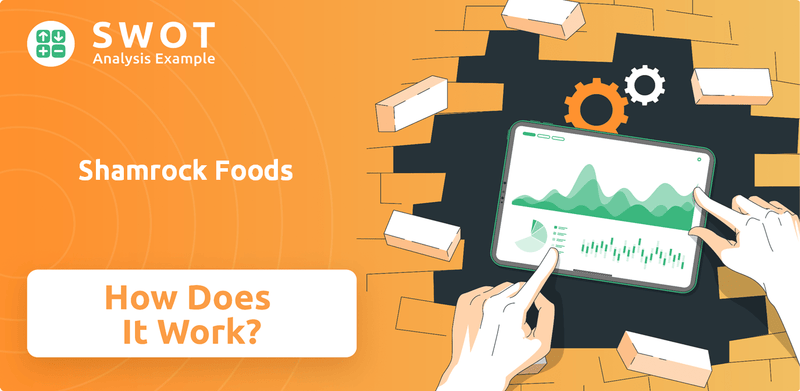
Understanding the inner workings of Shamrock Foods SWOT Analysis is crucial for investors and industry observers alike. Its intricate distribution network and strategic sourcing are key to its success. This exploration will uncover how Shamrock Foods leverages its logistical infrastructure to navigate the complexities of the food industry. We will examine its revenue streams and strategic moves.
What Are the Key Operations Driving Shamrock Foods’s Success?
Shamrock Foods Company creates value by combining food service distribution with dairy manufacturing. It provides a wide range of food products, from fresh produce to pantry staples, along with non-food supplies. These offerings serve various customers, including restaurants, healthcare facilities, and schools.
The company's operations involve sourcing from a global network, quality control, and advanced logistics. Shamrock Foods operates numerous distribution centers and uses refrigerated trucks for timely delivery. Its dairy subsidiary, Shamrock Farms, manages the entire dairy process, ensuring quality and freshness.
Shamrock Foods' unique approach combines broadline distribution with proprietary dairy manufacturing. This provides convenience, quality, and reliability. The company streamlines procurement with its extensive product catalog and branded dairy items. Strong customer service, including dedicated sales representatives and online ordering, further enhances its value delivery.
Shamrock Foods Company's food distribution network is extensive, utilizing multiple distribution centers strategically located to serve its customer base efficiently. The company focuses on 'last mile' delivery to maintain product freshness and meet diverse customer schedules. This network is crucial for its food service operations.
Shamrock Farms, a subsidiary, manages the entire dairy process, from farming to processing and packaging. This vertical integration allows for direct control over quality and freshness. The company produces milk, ice cream, sour cream, and cottage cheese, among other dairy products.
Shamrock Foods offers convenience, quality, and reliability through its broadline distribution and dairy manufacturing. The company's extensive product catalog, combined with its own branded dairy products, streamlines the procurement process for customers. Strong customer service, including dedicated sales representatives and online ordering platforms, further enhances its value delivery.
Shamrock Foods Company's core capabilities in efficient supply chain management, integrated logistics, and quality-controlled manufacturing translate into significant customer benefits. These benefits include reduced operational complexities, consistent product availability, and competitive pricing. This solidifies its market differentiation within the food distribution market.
Shamrock Foods Company's operations are designed to provide a seamless experience for its customers, focusing on efficiency and quality. The company's commitment to these principles is evident in its Growth Strategy of Shamrock Foods, which emphasizes continuous improvement and customer satisfaction. The company's success is built on its ability to manage a complex supply chain and deliver a wide range of products to various customer segments. The company's focus on its core operations and value proposition has allowed it to maintain a strong position in the food service industry.
Shamrock Foods Company's operations are characterized by several key aspects that contribute to its success in the food distribution and dairy manufacturing sectors. These elements include a robust supply chain, advanced logistics, and a strong emphasis on customer service.
- Supply Chain Management: The company sources products from a global network of suppliers, ensuring a diverse and reliable product selection.
- Logistics and Distribution: A modern fleet of refrigerated trucks and strategically located distribution centers are used to ensure timely and temperature-controlled delivery.
- Dairy Manufacturing: Shamrock Farms manages the entire dairy process, from farming to packaging, ensuring quality and freshness.
- Customer Service: Dedicated sales representatives and online ordering platforms enhance the customer experience.
Shamrock Foods SWOT Analysis
- Complete SWOT Breakdown
- Fully Customizable
- Editable in Excel & Word
- Professional Formatting
- Investor-Ready Format
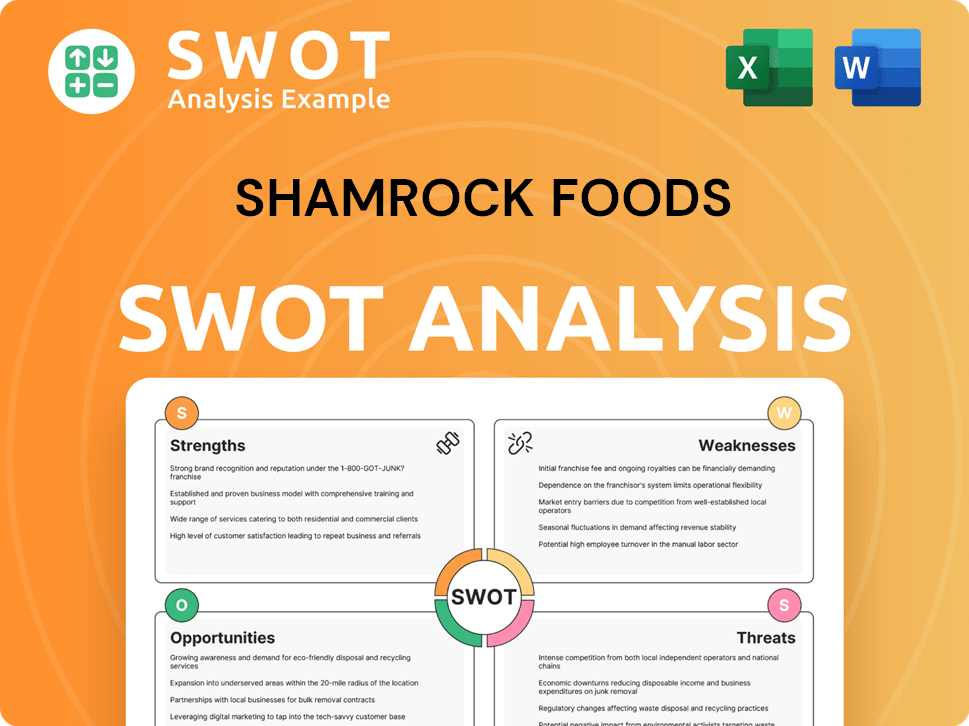
How Does Shamrock Foods Make Money?
Understanding the revenue streams and monetization strategies of Shamrock Foods Company provides insight into its operational success within the food distribution and dairy industries. As a privately held entity, specific financial details are not publicly available to the same extent as publicly traded companies. However, analyzing industry practices and business models offers a clear picture of how Shamrock Foods generates and manages its revenue.
Shamrock Foods' primary revenue sources are food service distribution and the manufacturing and sale of dairy products. The company leverages its extensive distribution network and established brand to maximize profitability. This approach enables Shamrock Foods to maintain a strong market presence and adapt to the evolving needs of its diverse customer base.
The food service distribution segment forms the backbone of Shamrock Foods' revenue, involving the sale of a wide array of food and non-food products to various customers. Revenue is generated through direct product sales, with pricing strategies often influenced by volume, contract terms, and market conditions. The company's significant reach within the food distribution market underscores the importance of this segment.
Shamrock Foods employs several strategies to generate revenue and maximize profitability. These strategies include direct sales, tiered pricing models, and cross-selling opportunities. The company's ability to adapt to market demands and customer needs is crucial for its long-term success. To learn more about their marketing approach, check out the Marketing Strategy of Shamrock Foods.
- Food Service Distribution: This segment involves selling a wide variety of food and non-food products to restaurants, healthcare facilities, and other food service establishments. Revenue is generated through direct sales, with pricing strategies influenced by volume and contract terms.
- Dairy Product Manufacturing and Sales: Shamrock Farms, the dairy division, manufactures and sells various dairy products like milk, ice cream, and cottage cheese. Revenue comes from wholesale sales to retail channels and through its own food service distribution network.
- Tiered Pricing Models: Shamrock Foods likely offers volume discounts and customized pricing for different customer segments, enhancing its competitiveness and customer retention.
- Bundled Services: Providing additional services like inventory management or menu planning can increase customer loyalty and perceived value, contributing to revenue.
- Cross-Selling: Leveraging its food service distribution network to sell its own manufactured dairy products effectively boosts sales and profitability.
Shamrock Foods PESTLE Analysis
- Covers All 6 PESTLE Categories
- No Research Needed – Save Hours of Work
- Built by Experts, Trusted by Consultants
- Instant Download, Ready to Use
- 100% Editable, Fully Customizable
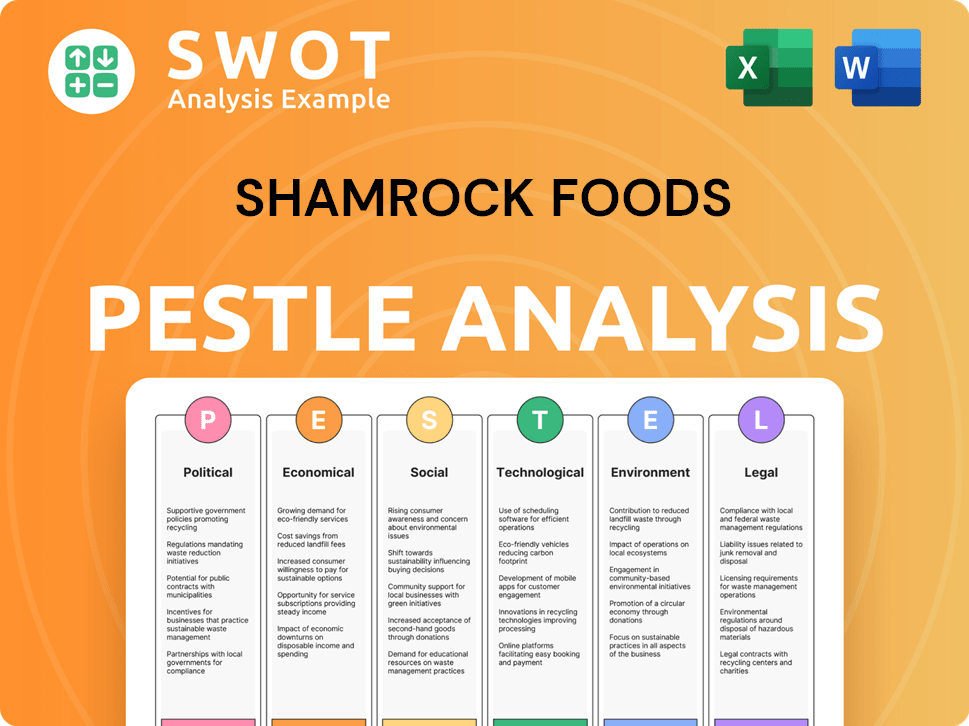
Which Strategic Decisions Have Shaped Shamrock Foods’s Business Model?
The history of Shamrock Foods is marked by significant milestones and strategic shifts that have shaped its current standing in the food distribution sector. While specific recent developments, such as major acquisitions or new product launches in 2024-2025, are not publicly available due to its private status, the company's consistent expansion and diversification over decades indicate ongoing strategic growth. A crucial early milestone was the transition from a family dairy farm in 1922 to a broadline food service distributor, a move that significantly broadened its market reach and revenue potential.
Subsequent strategic actions likely included the establishment of new distribution centers across the Western United States to enhance geographic coverage and market penetration. Partnerships with a broad network of suppliers have also been vital, ensuring a diverse and consistent product offering. The company's operational strategies have adapted to face challenges such as supply chain disruptions, a common issue in the food industry, through robust inventory management systems and a diversified supplier base. Regulatory compliance, particularly in food safety and transportation, is managed through adherence to stringent standards and ongoing efforts.
The company's response to market downturns, such as economic fluctuations, would typically involve optimizing operational efficiencies, managing inventory levels, and adapting pricing strategies to maintain competitiveness. Shamrock Foods has built a strong reputation in the food distribution market, focusing on customer satisfaction and operational excellence. Its ability to adapt to market changes and maintain strong relationships with both suppliers and customers has been key to its long-term success.
From its beginnings as a dairy farm in 1922, the company has grown into a major food service distributor. This expansion has involved strategic moves like establishing distribution centers and forming partnerships. These moves have been crucial to its growth and ability to serve a wide customer base.
The company has strategically expanded its distribution network across the Western United States. This has allowed for increased market penetration. They have also partnered with a wide range of suppliers to ensure a diverse product offering.
The company addresses supply chain disruptions through robust inventory management. They also handle regulatory hurdles by adhering to strict standards. The company adapts to market changes by optimizing operations and adjusting pricing.
The company's brand strength, built over a century, fosters customer loyalty. Economies of scale allow competitive pricing. Their integrated business model provides a unique edge. They also leverage technology for logistics and customer relationship management.
The company's competitive advantages stem from its enduring brand strength and extensive distribution network. Its long-standing customer relationships create a strong ecosystem effect, making it a preferred partner for many foodservice operators. The company continues to adapt to new trends, such as the increasing demand for sustainable and locally sourced products, by adjusting its procurement strategies.
- Enduring Brand Strength: A century of building trust and loyalty.
- Economies of Scale: Competitive pricing and efficient logistics.
- Integrated Business Model: Broadline distribution with proprietary dairy manufacturing.
- Extensive Distribution Network: Strong customer relationships and wide geographic reach.
Shamrock Foods Business Model Canvas
- Complete 9-Block Business Model Canvas
- Effortlessly Communicate Your Business Strategy
- Investor-Ready BMC Format
- 100% Editable and Customizable
- Clear and Structured Layout
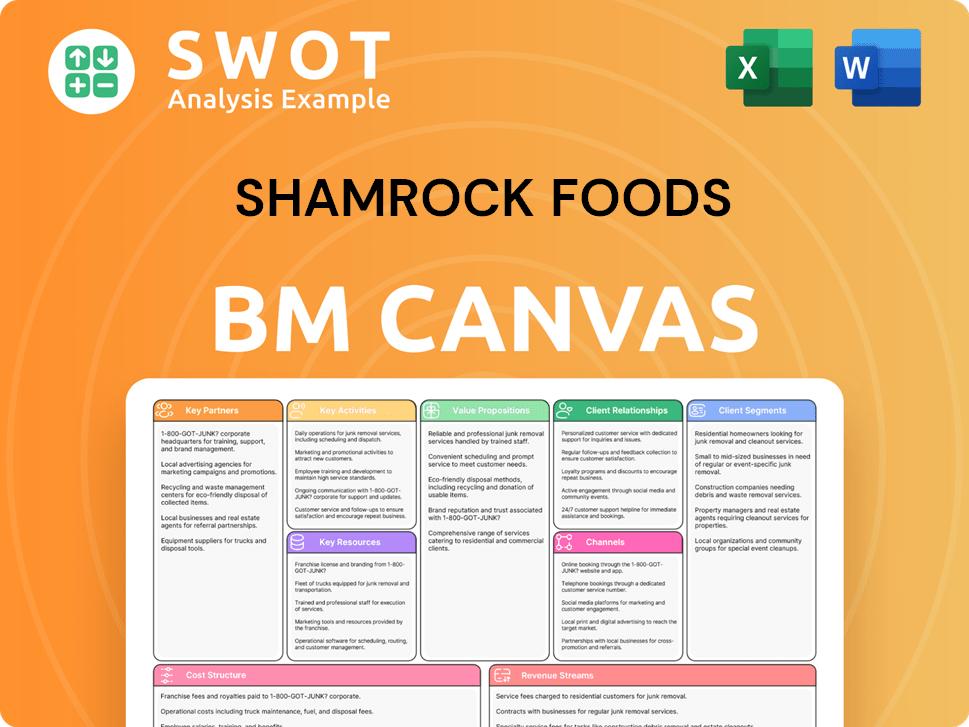
How Is Shamrock Foods Positioning Itself for Continued Success?
Shamrock Foods Company holds a significant position in the U.S. food service distribution and dairy manufacturing sectors, particularly in the Western United States. The company competes with major national distributors like Sysco and US Foods, while also facing competition from regional and specialized distributors. Its integrated model, combining broadline distribution with its own dairy production under the Shamrock Farms brand, gives it a competitive edge.
Several risks and challenges could affect Shamrock Foods. These include fluctuations in commodity prices, regulatory changes, and competition from new entrants. Technological advancements and changing consumer preferences also present challenges, requiring the company to adapt its strategies. Economic downturns and shifts in the restaurant and hospitality sectors further add to the risks.
Shamrock Foods operates within the competitive food distribution and dairy manufacturing industries. While specific market share data for privately held companies is not publicly available, its established presence in the Western U.S. suggests a substantial regional footprint. The company's integrated model, including its Shamrock Farms dairy brand, provides a competitive advantage.
Key risks include commodity price volatility, regulatory changes, and competition from new market entrants. Technological advancements and shifting consumer preferences, such as the rising demand for plant-based alternatives, also pose challenges. Economic downturns and changes in the restaurant sector can negatively impact the business.
Shamrock Foods is likely focusing on optimizing its supply chain, expanding its product offerings, and enhancing its technological capabilities. These initiatives may include investments in sustainable practices and automation. The company's history suggests a commitment to growth through operational excellence and customer-centricity within its core regions. Competitors Landscape of Shamrock Foods provides more insights into the market dynamics.
The company's strategic initiatives involve supply chain optimization, product expansion, and technological enhancements. Investments in sustainability, automation, and private label offerings are probable. These strategies aim to leverage the existing infrastructure, adapt to market changes, and enhance the value proposition for customers.
Shamrock Foods must adapt to changing market dynamics, including consumer preferences and technological advancements. The rise in demand for plant-based alternatives and the need for efficient last-mile delivery solutions are significant trends. These adaptations are crucial for maintaining competitiveness and meeting evolving customer needs.
- Prioritizing sustainable practices and reducing environmental impact.
- Investing in automation to improve warehousing and distribution efficiency.
- Expanding private label offerings to meet diverse customer demands.
- Enhancing technological capabilities for improved customer experience.
Shamrock Foods Porter's Five Forces Analysis
- Covers All 5 Competitive Forces in Detail
- Structured for Consultants, Students, and Founders
- 100% Editable in Microsoft Word & Excel
- Instant Digital Download – Use Immediately
- Compatible with Mac & PC – Fully Unlocked
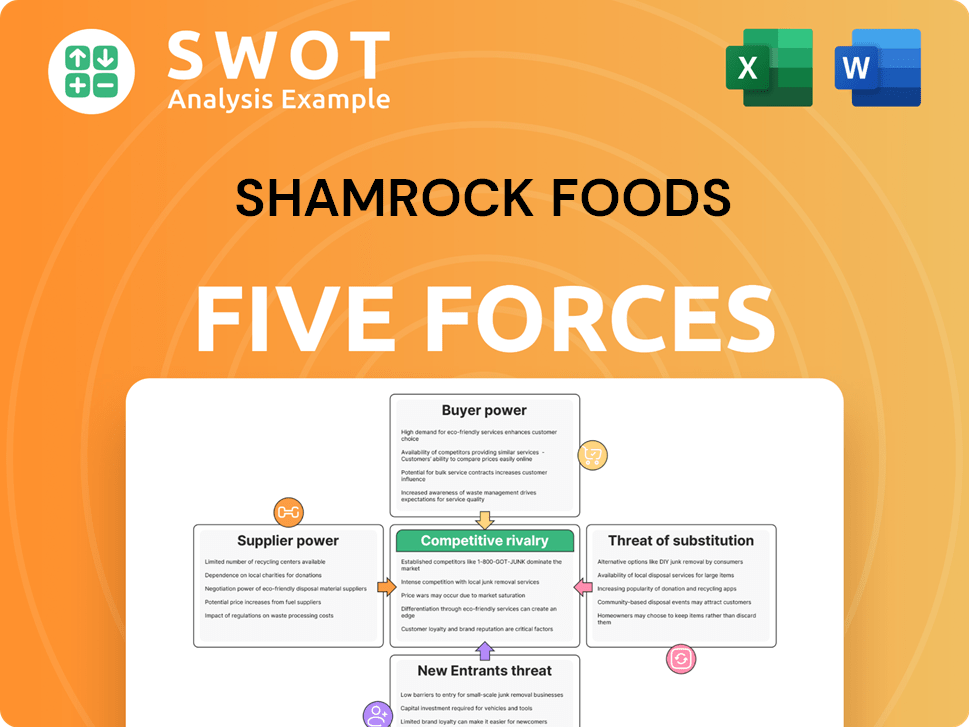
Related Blogs
- What are Mission Vision & Core Values of Shamrock Foods Company?
- What is Competitive Landscape of Shamrock Foods Company?
- What is Growth Strategy and Future Prospects of Shamrock Foods Company?
- What is Sales and Marketing Strategy of Shamrock Foods Company?
- What is Brief History of Shamrock Foods Company?
- Who Owns Shamrock Foods Company?
- What is Customer Demographics and Target Market of Shamrock Foods Company?
Disclaimer
All information, articles, and product details provided on this website are for general informational and educational purposes only. We do not claim any ownership over, nor do we intend to infringe upon, any trademarks, copyrights, logos, brand names, or other intellectual property mentioned or depicted on this site. Such intellectual property remains the property of its respective owners, and any references here are made solely for identification or informational purposes, without implying any affiliation, endorsement, or partnership.
We make no representations or warranties, express or implied, regarding the accuracy, completeness, or suitability of any content or products presented. Nothing on this website should be construed as legal, tax, investment, financial, medical, or other professional advice. In addition, no part of this site—including articles or product references—constitutes a solicitation, recommendation, endorsement, advertisement, or offer to buy or sell any securities, franchises, or other financial instruments, particularly in jurisdictions where such activity would be unlawful.
All content is of a general nature and may not address the specific circumstances of any individual or entity. It is not a substitute for professional advice or services. Any actions you take based on the information provided here are strictly at your own risk. You accept full responsibility for any decisions or outcomes arising from your use of this website and agree to release us from any liability in connection with your use of, or reliance upon, the content or products found herein.